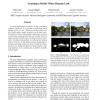198 search results - page 2 / 40 » Saliency-based discriminant tracking |
ICCV
2009
IEEE
14 years 10 months ago
2009
IEEE
For many applications in graphics, design, and human computer interaction, it is essential to understand where humans look in a scene. Where eye tracking devices are not a viable o...
ICCV
2009
IEEE
13 years 3 months ago
2009
IEEE
For many applications in graphics, design, and human computer interaction, it is essential to understand where humans look in a scene. Where eye tracking devices are not a viable ...
ICCV
2011
IEEE
12 years 5 months ago
2011
IEEE
In this paper we develop an algorithm for action recognition and localization in videos. The algorithm uses a figurecentric visual word representation. Different from previous ap...
ICMCS
2005
IEEE
13 years 11 months ago
2005
IEEE
Visual attention is obtained through determination of contrasts of low level features or attention cues like intensity, color etc. We propose a new texture attention cue that is s...
ECCV
2010
Springer
13 years 10 months ago
2010
Springer
Abstract. A major reason leading to tracking failure is the spatial distractions that exhibit similar visual appearances as the target, because they also generate good matches to t...

